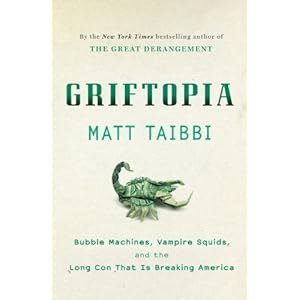http://theintelhub.com/2011/11/07/chemt ... rivatives/In his paper ‘Why in the World Are They Spraying?‘, journalist Michael Murphy floats the idea that chemtrails are sprayed in order to manipulate the weather derivatives market.
He posted the story right here on TheIntelHub.com on Oct. 11, 2011. It ran alongside my article ‘Chemtrails Exposed‘.
He may not be too far off the mark as my humble investigation leads me to many questionable situations, strange bedfellows and none other than those legends of corruption and waste, Enron. The thoroughly disgraced and vilified corporation was one of the founders of the market.
Would you put it past Enron?
Overview:
Weather derivatives are financial instruments (options, futures and options on futures) everyone can buy that either pay off or don’t pay off according to recorded atmospheric conditions such as temperature and rainfall. These instruments are mostly traded on the Chicago Mercantile Exchange (CME). They are also traded on smaller Over the Counter (OTC) markets.
Atmospheric conditions are recorded and published by authorized organizations.
Although they are available for frost, snowfall, rain, wind speed, and many others, the most common type of weather derivative by far is based on temperature. According to industry experts, temperature based weather derivatives account for 75-99% of all weather derivatives sold.
This is how temperature based weather derivatives work. Indices take a location’s daily average temperature, then a number is determined by how much that day’s average temperature deviates from 65 degrees Fahrenheit (or 18 degrees Celsius outside the U.S.).
The number deduced determines the derivative’s value and is usually aggregated over a period of weeks, months or seasons. Other indices simply aggregate average daily temperatures. In short, the day’s average temperature determines the derivative’s value.
You can bet that temperatures will be above or below the long term daily average for a particular date or group of dates.
The first weather derivative transactions were conducted over the counter in 1997 between Willis Group Holdings, Koch Industries, Pxre Reinsurance Company and Enron. These transactions followed the deregulation of the energy market in the U.S.
The weather derivatives market was greatly expanded in 1999 when weather derivatives began trading on the Chicago Mercantile Exchange.
The Weather Risk Management Association (WRMA) was founded in 1999 as well and is the leading industry association.
The founding members were: Aquila Power Company, Castlebridge Partners, Enron Capital and Trade Associates, Koch Industries, Southern Company Energy Marketing, and Swiss RE New Markets.
This year (2011), the WRMA released the results of a survey which pegs the current global weather derivatives market value at about $12 billion.
USA reported in it’s article ‘Weather Derivatives Becoming Hot Commodities’ that the largest broker of weather derivatives in the world is TFS Energy.
A man named Kendall Johnson, who is described as one of the industry’s most powerful professionals, states, “Businesses in the U.S., Japan, London and Amsterdam are the most frequent users of weather risk management, though companies in emerging markets like India are beginning to trade weather derivatives.”
Other big corporate players include: British Gas, Hess Energy, ABN Amro, Merrill Lynch, AXA Re, Swiss Re, Koch Energy, RenRe Energy, Nephila Capital, Munich Re, Speedwell Weather Derivatives, Vyapar Capital Market Partners, Galileo Weather Risk Management, PCE Investors / Cumulus, EDF Trading Limited, Risk Solutions International, E.ON Energy Trading, Mitsui Sumitomo Insurance Company and Endurance Reinsurance Corporation of America.
As you can see, re-insurers are some of the biggest market players. Geoffrey Considine, Ph.D. (a high profile weather derivatives industry insider) writes in his paper ‘Introduction to Weather Derivatives’, “There are a number of drivers behind the growth of the weather derivative market. Primary among these is the convergence of capital markets with insurance markets.”
Swiss Re is a name that comes up repeatedly and just happens to be the insurer of the World Trade towers at the time of the 9/11 attacks. But, I’m sure that’s just a coincidence. Nothing to see here… move along.
Enron:
By all accounts, Enron concieved and initiated the weather derivatives market.
According to ‘Weather Derivatives’ by authors from the London School of Economics, the Swiss Finance Institute and the University of Geneva, “…electronic trading platforms have always played an important role in the development of the market, especially Enron’s platform in the early days.”
Enron initiated the weather derivatives market in Europe as well. According to ‘Weather, Finance and Meteorology – forecasting and derivatives’ by Samuel Randalls, “In the UK, the first weather derivative deal was sold by Enron to Scottish Hydropower who, at that time, 1998, were taking part in a government pilot scheme for the privatization and deregulation of energy markets.”
In regards to Enron’s weather derivatives division known as ‘Enron Weather’, one of the co-authors of the book ‘Enron: The Smartest Guys in the Room’, Bethany McLean wrote me that, “A guy named John Sherriff was pretty instrumental in starting it, but the woman who ran the business, whose name was Lynda Clemmons, ended up leaving for a reinsurer – can’t remember the name of it – long before Enron’s bankruptcy.”
Lynda Clemmons now works as an advisor at Vyapar Capital Market Partners; a big weather derivatives player. John Sherriff is now the owner of Lake Tahoe Financial.
Market Participants:
The energy sector is the biggest buyer of weather derivatives because energy companies’ bottom lines and cash flows are largely affected by temperature fluctuations. This is why temperature based weather derivatives are the most prevalent.
Energy companies produce more power and thus increase cash flows when the weather gets either hot or cold because people use more air conditioning when it is hot and more heat when it is cold.
The weather derivatives market was created with the energy sector in mind. As we have seen, the market was founded by big energy players, most notably Enron. According to a Chicago Mercantile Exchange brochure, the 65 degree baseline selected for determining daily index values was chosen by the energy industry.
The terms used to describe index values are Heating Degree Days (HDD) and Cooling Degree Days (CDD). Heating Degree Days refer to the number of degrees Fahrenheit above 65 the average temperature of a Winter’s day is. Cooling Degree Days refer to the number of degrees Fahrenheit below 65 degrees a Summer’s day is.
It is this way because 65 degrees is about the temperature where if it is warmer than that, people use more air conditioning and if it is cooler than that, people tend to use more heating.
Industry publications claim substantial non-financial or non-energy sector participation in the weather derivatives market. Of businesses outside the finance or energy sectors, my investigation revealed very little participation. It is unrealistic that, especially in the tough economy we’ve been having lately, an organizer of an outdoor event, let’s say, would first of all even be aware of weather derivatives, much less use the time, energy, expertise and money to buy such things.
Businesses outside of finance and energy usually use more traditional forms of insurance or hedge with commodities contracts. Weather derivatives are almost entirely an energy and finance sector market. There is hardly any retail investor activity here.
Industry publications also often claim that weather derivatives are used by energy companies only as hedges against unforeseen demand lapses. If a particular Winter is too warm, for example, an energy company would not make as much money selling fuel as they would in an abnormally cold Winter. But, the reasoning goes, if they have purchased a hedge in the form of weather derivatives, they can make up those losses.
I assert that weather derivatives are traded like any other Wall Street market. To make a buck, they are traded any way possible. Enron, the founder of the market is famous for their trading desk which specialized in arbitrage.
The Bloomberg article ‘Hedge Funds Pluck Money From Air in $19 Billion Weather Gamble’ had it right. Nowhere in this article will you see any mention of non-financial or energy sector participation.
In fact, industry professionals are quoted as saying they are, “…using weather as market intelligence.” And that their business is, “…like playing poker.”
Because both weather derivatives and energy futures rise and fall depending upon temperature, the two markets are related. It is reasonable to assume that weather derivatives are traded in conjunction with energy futures.
Conclusions:
Are weather derivatives the reason chemtrails are sprayed? I don’t know. It’s very plausible. I believe I have provided here a great circumstantial case. The errant, singular chemtrail doesn’t support the ‘weather derivative market as a cause’ thesis because a lone chemtrail would not have a significant impact on temperature or any other atmospheric condition.
It might be done as a psychological operation. But, when downtown Phoenix is gridded with chemtrails on an otherwise clear day, producing a haze which is totally foreign to that climate, temperature (which drives weather derivative and energy markets) is probably effected significantly.
Does anybody out there know of a study showing how much influence stratospheric aerosols have on temperature? After a Google search, I couldn’t find one. Although, I did see some stuff that seemed to suggest that aerosols can move temperature 2 degrees F or more.
Weather derivatives by themselves are big money gambles. They may be valuable enough to make it worth putting planes up in the sky spraying stuff. If you divide last year’s total market value ($12 billion) by the number of traded contracts (466,000), you get the average contract value which is $25,321.
A matter of a few degrees on a given day or group of days could mean hundreds of thousands of dollars. The current weather derivatives market may not be big enough to support all chemtrail activity, but if you factor in the related multi-trillion dollar energy futures markets and energy company revenues, I don’t have much doubt that there is enough to support it.
The fact that chemtrails are sprayed over mostly urban areas makes sense if one of the desired effects is manipulated power usage. More people and therefore more power consumers affected per square mile means a more efficient operation.
The weather derivatives market and probably other opportunities were made possible by deregulation of the energy market. Enron founded the weather derivatives market. Was the Department of Energy in bed with Enron? I wouldn’t doubt it.
The fact that Enron founded the market is very dubious. This is a company whose accounting firm, Arthur Andersen, shredded more than a ton of their documents in one day as Enron’s chairman Ken Lay told everybody everything was fine.
When Enron CEO Lou Pai’s wife found out about his stripper girlfriend complete with his love child, she divorced him. Enron’s bankruptcy resulted in at least 33 criminal charges against employees and executives. People suffered under high power costs inflated by Enron. When Enron and their cronies intentionally disrupted power service as they were known to do, people were injured and died. Who knows how many bodies they left? These guys were not playing patty cakes. These guys ARE the Nazi party. Have you ever heard of something called ‘Operation Paperclip’?
If you like being ripped-off, beaten and murdered, you’ll love these guys. Personally, I’m not into that. I wouldn’t put anything past Enron.
Don't believe anything they say.
And at the same time,
Don't believe that they say anything without a reason.
---Immanuel Kant





